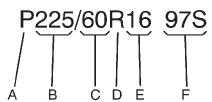Tire Designations
Tire Size
The following is an example of a typical passenger vehicle tire size.

(A) Passenger (P-Metric) Tire:
The United States version of a metric tire sizing system. The letter P as the first character in the tire size means a passenger vehicle tire engineered to standards set by the U.S. Tire and Rim Association.
(B) Tire Width: The three-digit number indicates the tire section width in millimeters from sidewall to sidewall.
(C) Aspect Ratio: A two-digit number that indicates the tire height-to-width measurements.
For example, if the tire size aspect ratio is 60, as shown in item C of the illustration, it would mean that the tire's sidewall is 60 percent as high as it is wide.
(D) Construction Code: A letter code is used to indicate the type of ply construction in the tire. The letter R means radial ply construction; the letter D means diagonal or bias ply construction; and the letter B means belted-bias ply construction.
(E) Rim Diameter: Diameter of the wheel in inches.
(F) Service Description: These characters represent the load index and speed rating of the tire. The load index represents the load carrying capacity a tire is certified to carry. The speed rating is the maximum speed a tire is certified to carry a load.
See also:
Overview
A. RADIO/BAND . Changes the band while listening to the radio.
► Selects the radio when listening to a different audio source.
B. CD/AUX . Selects the CD player or an external audio source ...
Setting the Tone(Bass/Midrange/Treble)
AUDIO: Push and release the AUDIO knob until
BASS, MID (midrange) (without Bose®), or TREB
(treble) displays. Turn the knob to increase or to
decrease the tone. The display shows the bass,
midran ...
Safety
Side-impact airbags and all-disc antilock brakes are optional.
Driving Impressions
Despite structural similarities to the wildly styled Pontiac Aztek, Buick’s
crossover model has a personality ...


